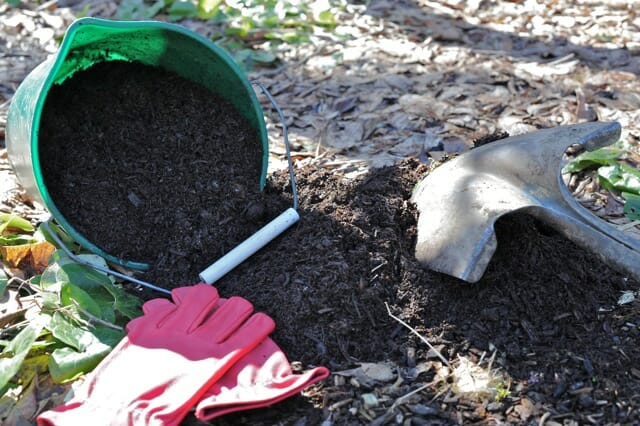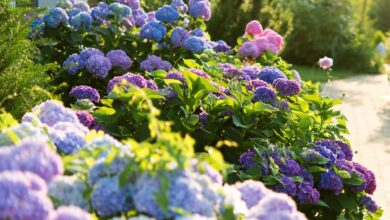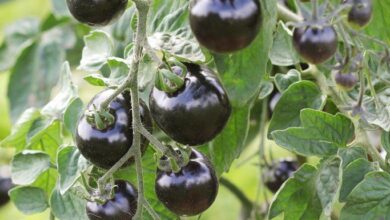
how mulch works (and how to use it), with bill fonteno
[ad_1]
I GET A LOT of questions every year about mulch, about how to use it, when to use it, which kind to use. I wanted to learn more about all that, but also even more important about what goes on in the soil beneath that mulch layer when you mulch with an organic material.
To learn about all that I talked to Bill Fonteno, Professor Emeritus of Horticultural Science at North Carolina State University and former technical advisor to the U.S. Mulch and Soil Council, the industry trade association.
Read along as you listen to the May 23, 2022 edition of my public-radio show and podcast using the player below. You can subscribe to all future editions on Apple Podcasts (iTunes) or Spotify or Stitcher (and browse my archive of podcasts here).
 using mulch (and mulch works), with bill fonteno
using mulch (and mulch works), with bill fonteno
Margaret Roach: Hi, Bill.
Bill Fonteno: Hi, Margaret. Thanks so much. I appreciate the opportunity to chat about one of my favorite subjects.
Margaret: [Laughter.] Me, too. Me, too. You know I’m a mulcher. So I so enjoyed collaborating with you on a recent “New York Times” gardening column, which was so popular, because as I said in the introduction, people have lots of mulch questions and concerns.
So maybe we start with some of the basics, like how I told you when we worked on that story, all the years I’ve been mulching, every spring, I always thought of it as I watched it sort of break down as if it were an act of… I called it “passive composting.” And you kind of gave me another mental image that was much better, and more accurate. Can you tell us about that, that sort of forest imagery?
Bill: Well, it actually came about to me only recently. I was thinking about when you have to improve these garden soils and urban soils, that you would have to build on them. And that was the focus. But I learned recently about the way farmers work on their soils, because I heard that when farmers grow things, they always grow two things. They grow their crops and they grow their soil. And that got me thinking about that process.
And that’s the way it works in nature, in forests. It’s the leaf litter. It’s the leaves and twigs and things that fall to the ground and the plants that die, that are slowly decomposed and are returned naturally to the soil. And so mulching, particularly in organic materials, is just the same kind of process, or can be. Instead of thinking of mulching as something just to retard water loss or to mitigate temperatures, it’s really also about building soils on a regular, natural basis.
Margaret: Right. So I had thought composting, but that’s when I’m out there with the fork, and I’m turning it. And it’s piling up deep. And it’s not like that. It’s like that duff layer in the forest, which I thought was so beautiful and so accurate. So what’s the science of what goes on in that layer, or beneath that layer? What’s really happening when it breaks down?
Bill: Well, the breakdown is all due to consumption of that material by microbes of all different types, of bacteria, fungi, earthworms, all protozoa, all the different things, all the microbes that live in the soil. And as they consume those things, the material itself changes from recognizable pieces, like leaves and twigs and things like that, and they become unrecognizable first, as they break down. And then they ultimately move into a humus-type material.
And then from that, this black ooey-gooey stuff called humates, which is a collection of all kinds of different chemicals, tends to emerge. And it’s those humates themselves that begin to ooze into the soil. Gravity pulls them down into the soil. And they are very sticky. Soil has a very high binding process to it, and it attaches itself to these things. And these are the soil particles like sand and silt and clay, which are the basis of almost all soils.
And as this material attaches to the particles, it literally binds them together. It pulls them closer together in small, little aggregates. It makes the little particles into a little bit bigger particles. And once that happens, it also then pulls those particles apart. Those aggregates actually begin to have spaces between them. And actually, it’s those spaces that are the important part, because that allows the water to move into the soil. That allows the air space to be increased. That allows oxygen and carbon dioxide exchange in the soil. And allows for better tilth in the soil itself.
So it’s a very natural process. And it’s the way forests feed themselves. It’s just basically with the remnants of those that came before them.
Margaret: Right. I hate when we think of it as debris, because it’s not debris—you know what I mean? Debris sounds like something you want to get rid of. But it’s, oh, my goodness, it’s life-giving, this stuff, right?
Bill: Well, that’s exactly right. Well, it’s debris for us. [Laughter.] It’s like, a weed for us is any plant that is not where we want it in our garden. But they’re just regular, natural plants that are just trying to get along with everybody else.
Margaret: Do their thing. Right, right. I remember that you told me, when we were doing the Times story, you said even in urban soils, where there’s no topsoil layer, this process can begin to build soil in three to four years. That’s pretty miraculous.
Bill: Well, and that was through some work that was published a while back. Say you’ve got bad topsoil, or no topsoil, and so you’re basically dealing with subsoil layers, you can simply spread an organic mulch out, about 3 or 4 inches thick, and you don’t touch it. All you do is spread it out. And every year you just make sure that you keep about that same level of… You add a little bit more to the top.
You don’t turn it. You just add a little more to the top, and the stuff near the bottom begins to break down. And it will, after three or four years, if you push that mulch layer away, you will find the soil, instead of being sort of a grayish or light brown color, will actually be dark. That’s the humates that it has in it. It will have better tilth in it. And it will actually begin to look like and make soil. And that’s with doing absolutely nothing except putting it on the top.
Margaret: Right. Right. So you mentioned a couple of the other benefits of mulch: retarding water loss, and regulating the temperature of the soil and so forth. What are some of the other benefits? What about with weeds and so forth? How does it help us with that?
Bill: Well, it can be a weed barrier, for sure, because weeds need to have good contact with the soil particles themselves. They need moisture and the right temperatures in order, of course, to germinate. And so mulches are one of the best ways, if you want to reduce your weeding, the first step is to mulch your soil around the plants. And that way, most of the weed seeds will not get a chance to get a foothold on the soil surface themselves. So they can actually begin to germinate, but there’s nothing for them to penetrate into. And then they stop.
Margaret: Right. And some seeds need light to germinate. So if they’re under the mulch, I assume they’re not going to do as well, either.
Bill: Well, usually, that’s very true. Some need light to germinate. Some need darkness to germinate.
Margaret: Oh, O.K.
Bill: Many of the seeds that we see do need light. And generally, the smaller the seed, generally the more light they’re going to need, simply because they’re probably wind-dispersed, where they just fall on the ground. And so evolutionarily, they’re used to having light in that process. So if you’ve got a layer of mulch on, and the seeds do land on the mulch, and maybe they fall down a little bit into the mulch itself, they don’t have what they really need. Their environment is not the same as that would be the best for them. So it becomes harder for them to get a foothold again.

But if I dumped a bunch of mulch on those beds that I hoped that self-sowing was going to happen in too early, I would smother those. The mulch would be serving the purpose you’re talking about, but it would be countering what I want. And so I wait. You know what I mean? So it’s learning the timing also, which we’re going to talk about.
So you want the advantage, but you also don’t want to shoot yourself in the foot a little bit sometimes [laughter] when you have certain areas that you have something going to volunteer. [Above, breadseed poppy volunteers, plus tiny nicotiana seedlings just emerging in mid-May.]
Bill: Yeah. That’s exactly right. Almost every rule that you have in gardening, actually the caveat to that on the last part of it is always, “It depends.” [Laughter.] And in this case, it depends on what you’re trying to do. And if you do have these reseeding materials that you have, then really thick layers of mulch, early, is going to not necessarily be a good thing for them. So waiting for the right time to make that happen.
Margaret: Yeah. So what makes good mulch? And what’s the difference between the different materials? I mean, because we’re not talking about bags of shredded rubber here or plastic sheeting, we’re talking about organic material, plant-based materials. What makes good mulch?
Bill: Yes. Generally, if we’re talking organic materials, they fall into two or three categories. Manures sometimes can be used as mulches. But generally, we tend to use that more for nutritional purposes rather than mulching themselves.
Most of the mulches that we use organically are plant-based or old plant parts, everything from the grass clippings, to the leaves that land in the fall, to yard trimmings when you’re pruning your trees or trimming back your hedges and things like this, are great ones. Things like pine straw, if you’re in an area that has acidic soils that support pines. These are all common, sort of small, quickly reducing materials.
What we tend to see also a lot is bark, both hardwood bark and softwood barks. Now, further north, maybe up where you are, the hardwood barks tend to be a pretty popular thing. The hardwood barks are more popular up North, although we have some hardwoods here in the South. But in the South, a lot of it is pine bark, particularly.
And you can size them. The barks don’t come in different sizes. It’s basically bark, but they screen it, of course, into basically large and medium and smaller sizes. They are popular, because they’re dark-colored to start with. Plus, they tend to break down more slowly.
And so because mulch does have the tendency to degrade, and as it degrades the levels go down. And so some homeowners are… You spend a little money, you put some bark out or you put some mulch out, and then next year it’s almost gone.
Well, many people find that to be irritating, because then they have to reapply it. But as we were talking before, if you think that you’re building soil, then that’s actually kind of what you’re looking for, is you’re actually trying to use the mulch as a slow way of adding nutrients in a more natural system.

Bill: Yeah. That’s usually it. The smaller the particles, the faster they break down in general. And so, of course, the last thing that I did mention was wood chips. And wood chips themselves, obviously, they’re becoming very popular in gardens for a number of things. They’re used both as a substrate for growing, and also as mulches.
Now, the wood chips are probably one of the most resilient materials, and they break down slower. The bigger the particle, not just the slower that they break down, but the larger size actually means that the surface area, per square foot of garden space of the surface area of mulches, are smaller. The smaller the size, the greater the surface area. The greater the surface area of your mulch, the faster it breaks down.
Margaret: O.K. So one thing that I have to ask then about that, because I’m asked this a lot, when mulching with a wood product—and especially what you just said, big chunky wood chips, especially ones people get the free delivery when the arborist comes and then a tree is shredded up and so forth—will using a wood product in some way rob nitrogen from the plants, from the soil? When is that a factor, or is that a factor?

But if it is big, chunky pieces, it will be slower. And the bigger and chunkier the pieces, the less reactive it is and the slower it breaks down. But if you start putting more like pine sawdust or things like this, that’s highly reactive.
And we all know that the old saying is, “You don’t want to put sawdust in, because it’ll rob nitrogen.” Well, it does. But people sort of say that that’s what wood does. And the studies that we’ve been doing for the last 10 years show that that’s not really true. With the bigger pieces, they don’t do that.
And the chips that you see from the arborist are actually a hundred times bigger than sawdust. And so they can, if you put a ton of this on, or you incorporate it in, there’s a chance that you lose a little bit of the fertility—I mean, that it will rob a little bit of the nitrogen.
And if you are organically applying the nitrogen, you’ll probably see it more. Not because it’s organic, but because in the natural system, organic nitrogen is just… I mean, nitrogen from organic sources just is less. But if you are using a commercial fertilizer, like an 8-8-8 or 10-10-10 in your system or anything like that, then you probably won’t see much.
That’s one of the things that we saw in a lot of the wood research that my colleague, Brian Jackson, and I have been working on for a long time. People kept warning us that it’s a big problem with wood, because wood robs nitrogen. But that actually is something to be aware of, but it’s not as prevalent as one would think. [Above, wood chip photo from Wikipedia.]
Margaret: So raw and the sawdust-type, if you put a thick layer of something like sawdust on that would be a problem, or maybe too much raw wood. But it’s not always a problem.
Bill: No. There are gardeners that swear by their wood chips. And they grow in nothing but that—they don’t even put it in the ground. They’re using the wood chips for their soil base. And they just spread it on top of their terrible soil, and they grow in them.
So it’s not as bad of an issue. If you are organic, and say you use compost as your natural nitrogen source, then you might need to put a little more, or it might be a little more of an issue then, but generally, it’s not that big of a deal.
Margaret: So I just want to kind of run through, quickly, some… I like mulch that isn’t too coarse, for my garden beds. I mean, that isn’t too coarse nor too fine. I don’t like big chunks, and I don’t like it to be like compost, because that, to me, is not a mulch. That’s what I put under my mulch if I’m topdressing, screened compost or whatever.
And I like it to be brown in color. You mentioned that. I like it to sort of not scream. I don’t like the dyed mulches.
But how deep should I apply mulch? And when should we apply? A little bit of the protocol kind of. I do it every spring. I just do it as almost a religion. It’s what I do when I top up that layer to where it was, and that’s my system. But how deep?
Bill: Well, you’re right in that that darker color is what most people are looking for if they’re looking for a natural color type of mulch. But all mulches, whether it’s say hardwood barks or pine barks or things like that, will fade in color for the next year. And so naturally, putting some more on top, just as a little topdressing, is not a bad thing. Most people will pick around in their mulch to kind of up the color a bit. But one of the best ways to do that is just to apply a small layer on the top.
Now, how much do you apply? Well, generally, you need at least about an inch to get any kind of depth to the mulch, to where you begin to see any kind of mitigation in temperature or anything like that. But generally, up to about 3 inches. So 1 to 3. If you want to go 4, that’s O.K. But generally, 1 to 3 is about what most materials can be used at.
And it doesn’t really matter whether it’s a finer material or a… If it’s a very fine material, then an inch of that would probably be enough. But if it is a coarser material, you can easily put 2 to 3 inches in there if you want.
Margaret: Right. And obviously, for gardeners, if they have some tiny little delicate creature about to emerge under it, again, you don’t want to put 4 inches on top of that thing that’s just about to come up [laughter]. You know what I mean, judgment, judgment, like you said, “It depends,” so-
Bill: Yeah. Oh exactly. And if you put 4 inches or 5 inches of a very fine mulch on there, you’re going to actually retard some of the gas exchange in the soils underneath it. So it’ll be slower for the oxygen to come in and for the CO2 to leave. And so the microbes may or may not, depending on your texture of your soil, be happy.
Now, if you got a very sandy soil, it’s not going to affect it too much. But with most people that have more silt and clay in their soils, it can be somewhat of a problem. Yeah.

Bill: Well, it was very interesting, because it was like a kind of a halfway-decent idea run amok [laughter]. Because in commercial landscape installations, that’s a generally very big system, and it takes a lot of mulch to cover or a lot of material, of soil amendments, to prepare and make better soils. It takes a lot of it to do that—yards and yards and yards of…cubic yards of material. And so many times, contractors don’t want to spend that money.
So they tend not to do much in the way of soil prep. Well, in places where the soil is really bad, where the topsoil’s been pulled away and it’s just subsoil and it might be somewhat compacted, there were situations where the plants actually did better, longer, if you took the plastic pot off the plant, you sat it on the soil, and you mulched around the root system. You just sort of piled it up around the root system, which kind of made us a big pile of mulch on the base.
And the plants actually do better, because they stay in the mulch, the roots do. And as long as you water it, it works out pretty well. But then people have taken that to the extreme. They see that, and they see that looks like how to do that. And so they do that in regular soil.
But that’s the last thing you want to do, is to take a decently prepared soil, plant your plant in there, and then mound up a bunch of mulch around it, because lo and behold, the roots do the same thing. They grow into the mulch. And if you’ve got decent soil, that’s where you want them to be. If you mulch around it too high, they literally climb into the mulch itself, because that’s where probably the best air-and-water relationship is for those plants. So under times of stress, or water, or, or too much heat, it can become problematic.
So mounding it up around the base of a plant is bad news. Plus, it is also not the right environment for around the trunks. In nature, you don’t find things piled up around the base of a plant. So in order to prevent disease and to make the roots do what they’re supposed to—and that is to move into the soil—then it’s not a good idea to mound around the roots like that.
Margaret: Well, Bill, I was so glad that you made time today to talk about this on the show. And I’m going to give some links and so forth to the FAQ page of commonly asked questions and answers from the U.S. Mulch and Soil Council website, and some other such resources for people listening to the program who want to learn more. And thank you again. And thanks again for helping me with the Times story, that was so popular about our favorite topic: mulch [laughter]. I’ll talk to you again soon, I hope.
Bill: Oh, thanks, Margaret. My pleasure.
more mulch information
prefer the podcast version of the show?
MY WEEKLY public-radio show, rated a “top-5 garden podcast” by “The Guardian” newspaper in the UK, began its 11th year in March 2020. In 2016, the show won three silver medals for excellence from the Garden Writers Association. It’s produced at Robin Hood Radio, the smallest NPR station in the nation. Listen locally in the Hudson Valley (NY)-Berkshires (MA)-Litchfield Hills (CT) Mondays at 8:30 AM Eastern, rerun at 8:30 Saturdays. Or play the May 23, 2022 show using the player near the top of this transcript. You can subscribe to all future editions on iTunes/Apple Podcasts or Spotify or Stitcher (and browse my archive of podcasts here).
[ad_2]



 using mulch (and mulch works), with bill fonteno
using mulch (and mulch works), with bill fonteno



